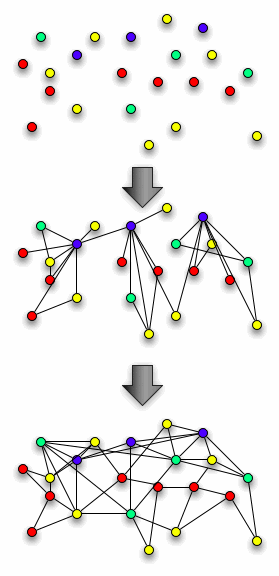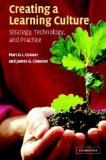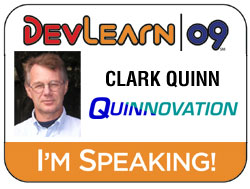In prepping for tomorrow nights #lrnchat, Marcia Conner was asking about the value proposition of virtual worlds. I ripped out a screed and lobbed it, but thought I’d share it here as well:
At core, I believe the essential affordances of the virtual world are 3D/spatial, and social. There are lower-overhead social environments (but…which I’ll get back to). However, many of our more challenging tasks are 3D visualization (e.g. work of Liz Tancred in medicine, Hollan & Hutchins on steamships). Also, contextualization can be really critical, and immersion may be better. So, for formal learning in particular domains, virtual environments really make a lot of sense. Now you still might not need a social one, so let’s get back to that.
The overhead is high with virtual worlds on the social issue, so ordinarily I’d not put much weight on value proposition for informal learning, but… two things are swaying me. One is the ability to represent yourself as you’d like to be perceived, not as nature has provided. The other is the ephemeral ‘presence’ and the context. Can we make a more ambient environment to meet virtually, and be fully present (in a sense). Somehow there’s less intermediation through a virtual world than through a social networking site (with practice).
And one more thing in the informal side: collaborative 3D creation. This is, to me, the real untapped opportunity, but it may require both better interfaces, and more people with more experience.
Now, there’s certainly a business case for learning in virtual worlds *where* there’s an environment that really needs 3D or contextualization, but does it need to be massively social (versus a constrained environment just for education, built in something like ThinkingWorlds)?
And we know there’s a business case for social, but is the overhead of virtual worlds worth it?
However, when we put these two together, adding the power of social learning onto the formal 3D/spatial, and in the social adding the ephemeral ‘presence’ *and* then consider the possibility of 3D spatial collaboration (model building, not just diagram building), and amortize the overhead over a long term organizational uptake, I’m beginning to think that it may just have crossed the threshold.
That is, for formal learning, 3D and contextualization is really underestimated. For social learning, presence and representation may be underrated. And the combination may have emergent benefits.
In short, I think the social learning value of virtual worlds may have broader application than I’ve been giving credit for. Which isn’t even to mention what could come from bridging the social network across virtual, desktop, and even mobile! So, what say you?




 Based on the principles from our CLO
Based on the principles from our CLO